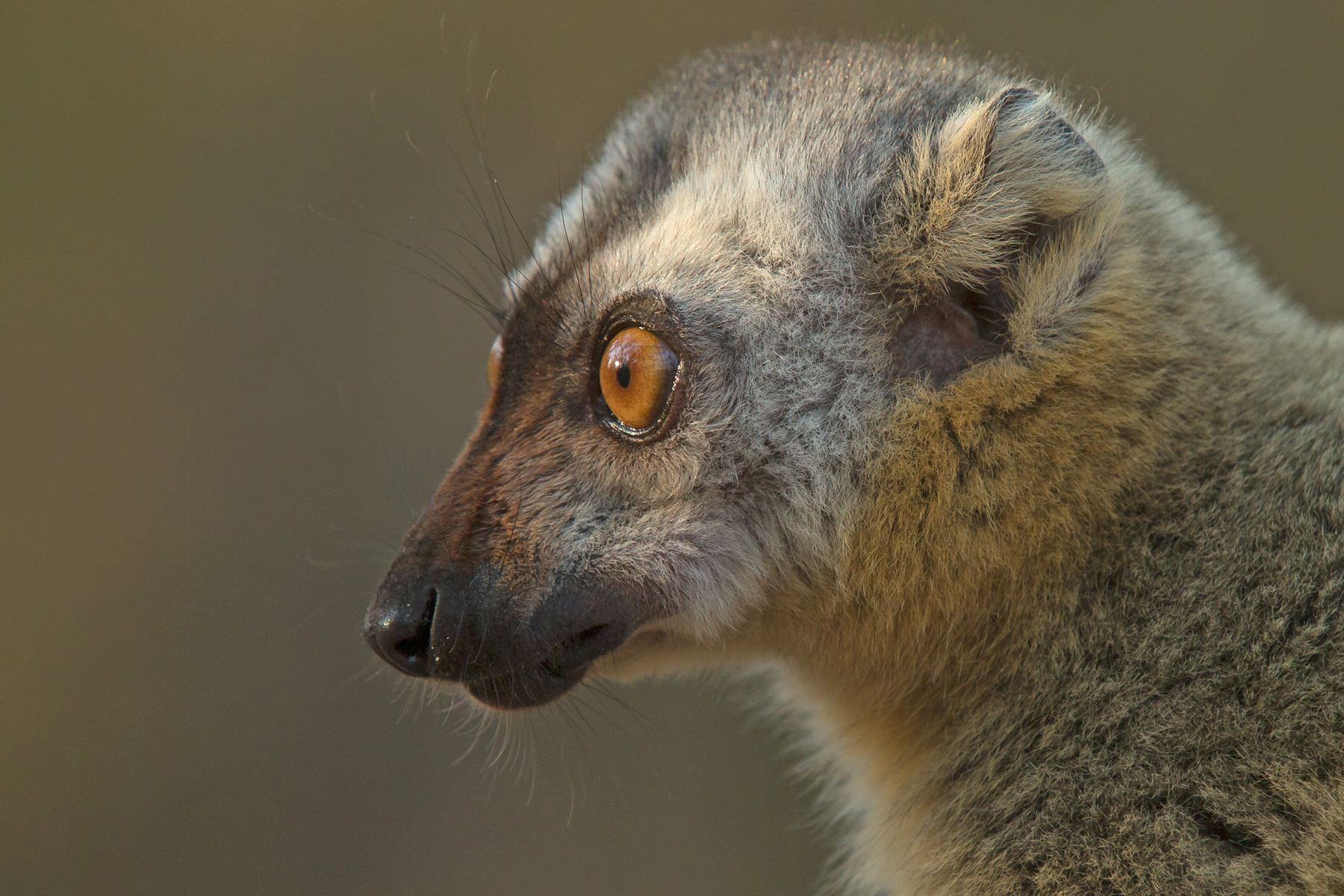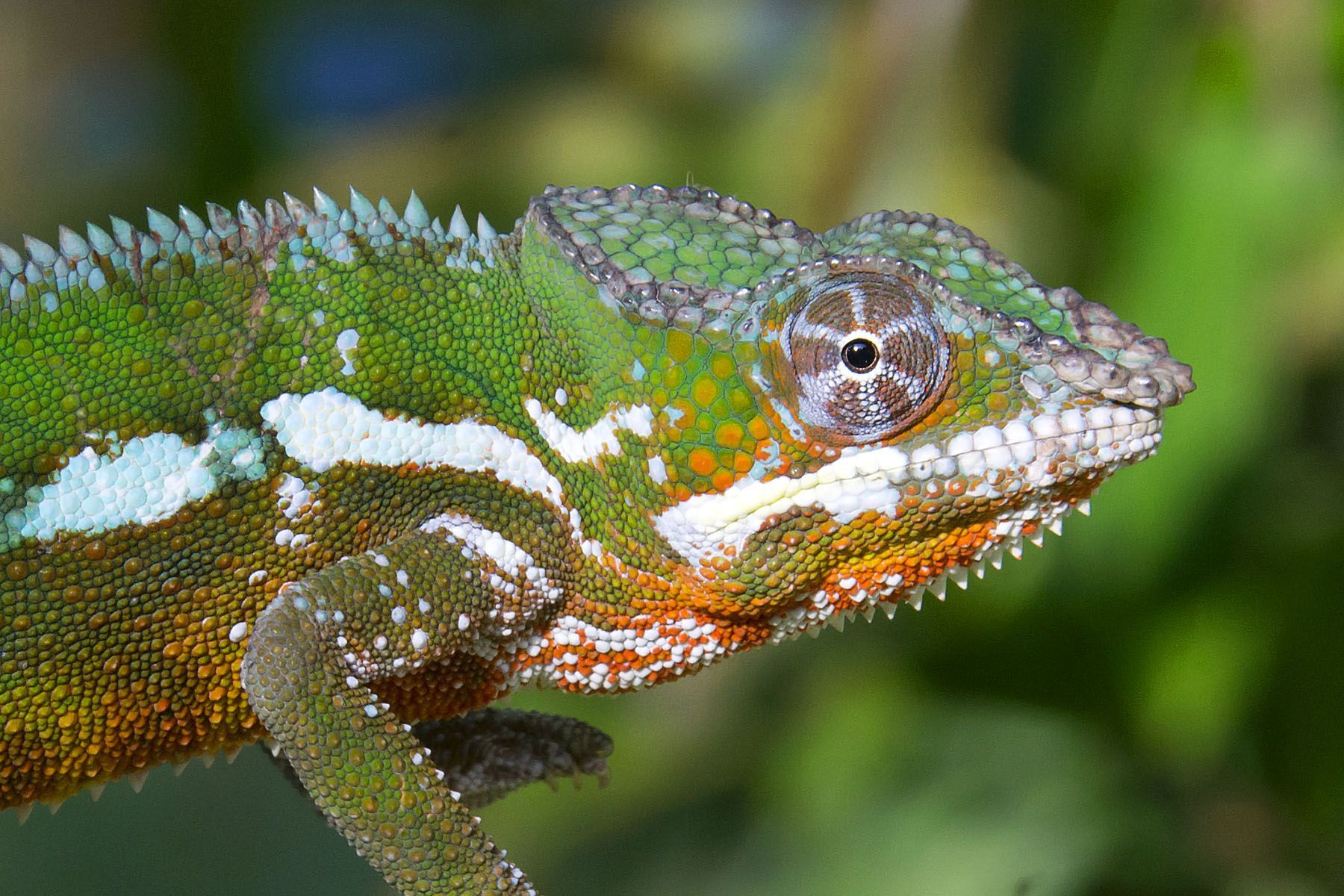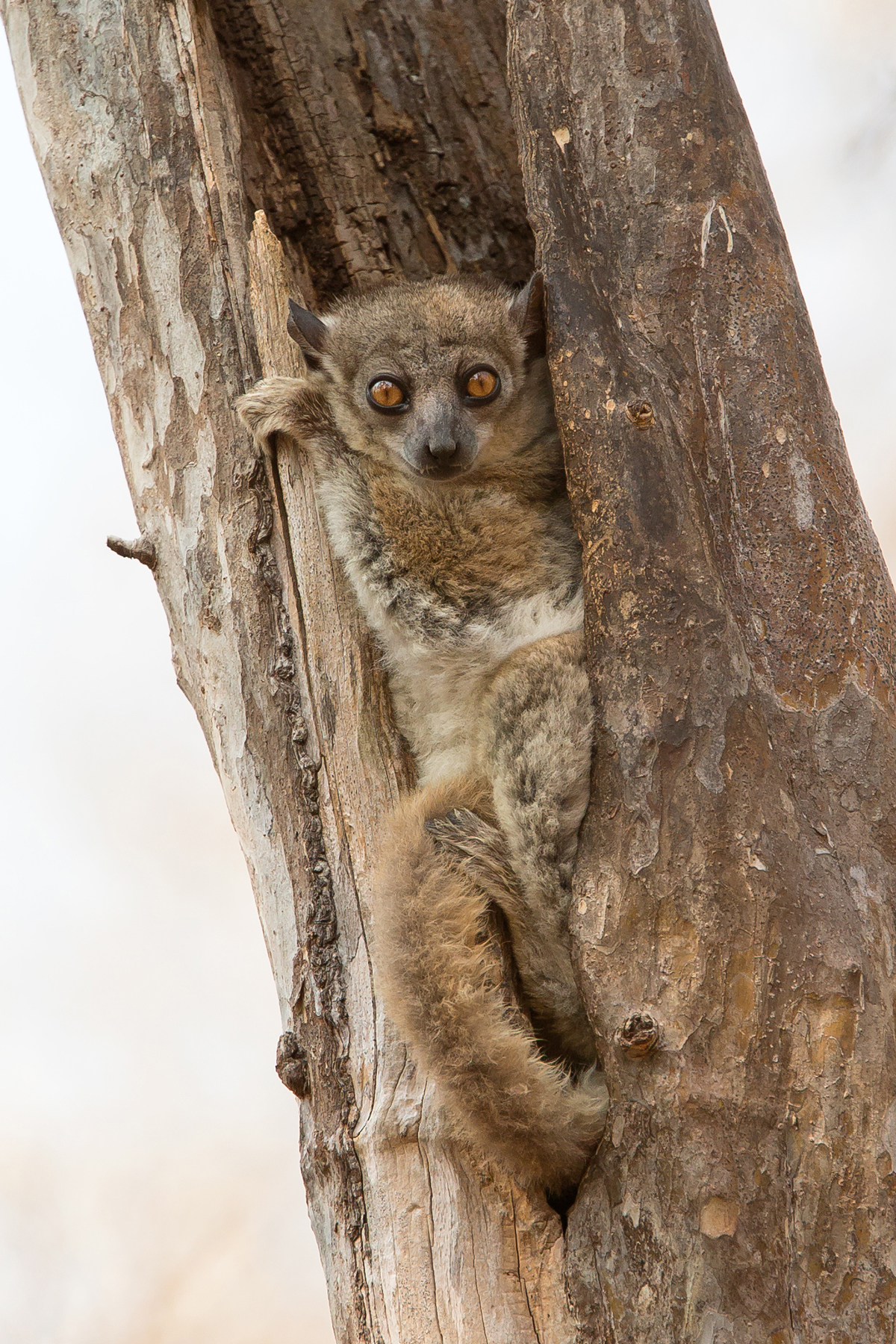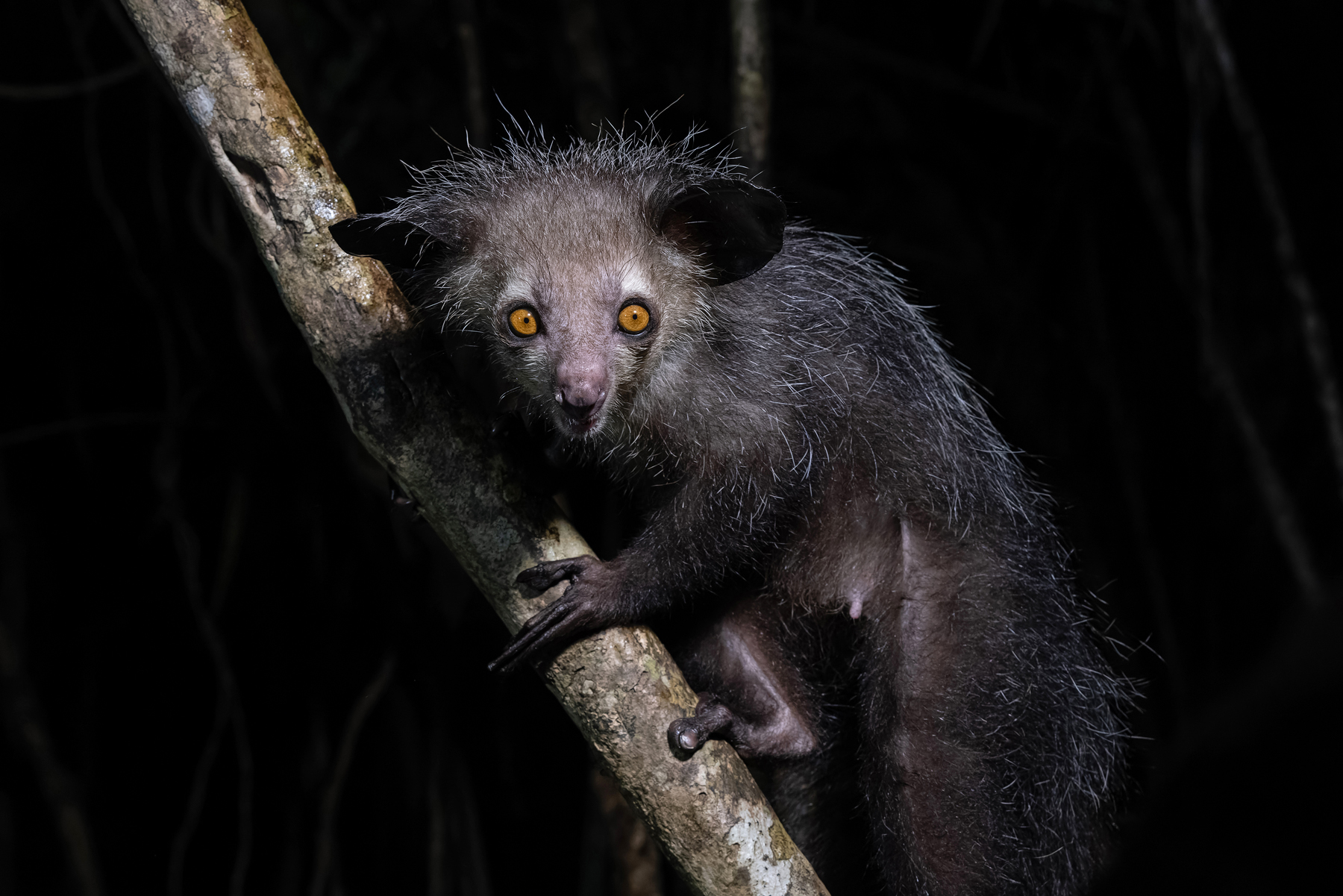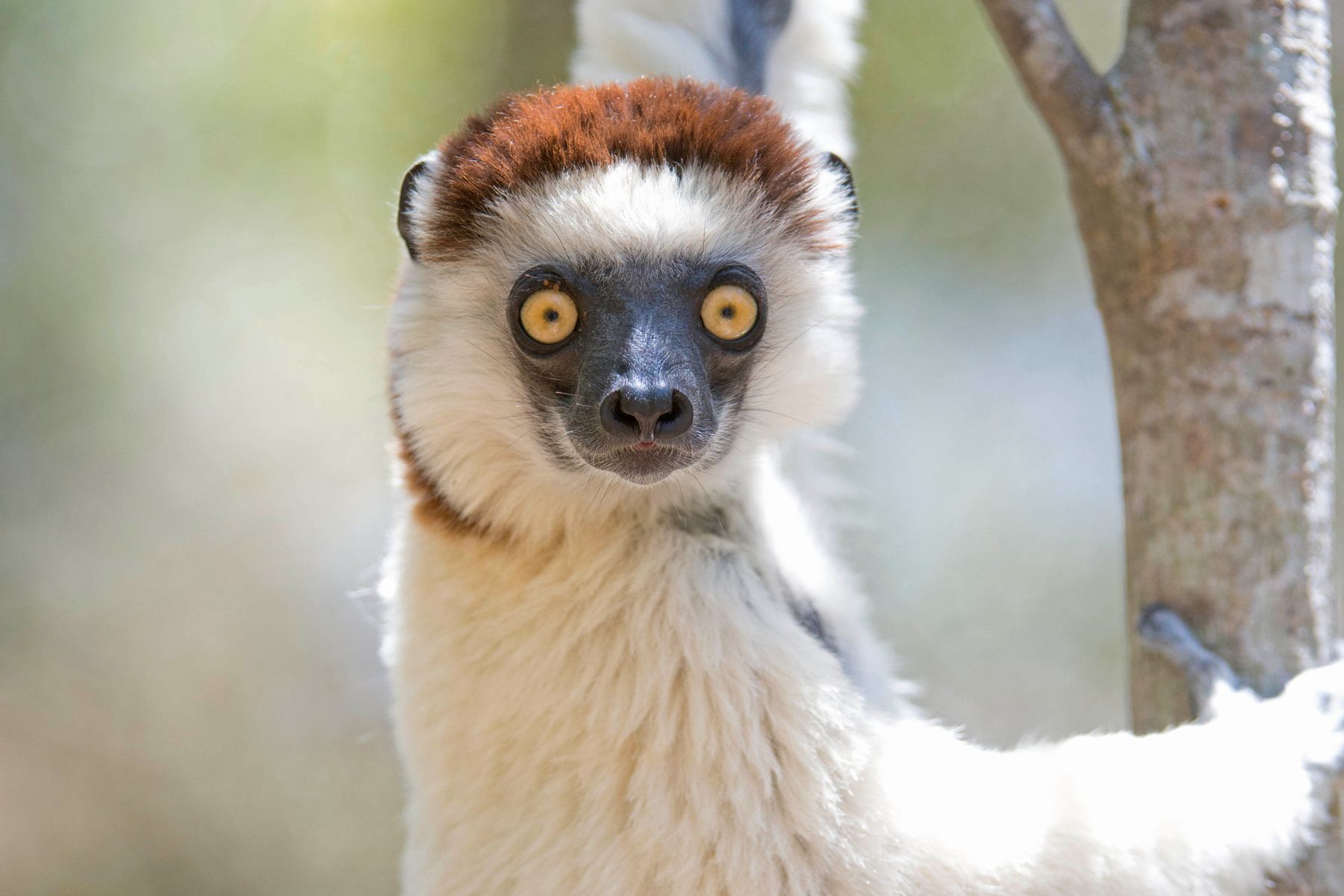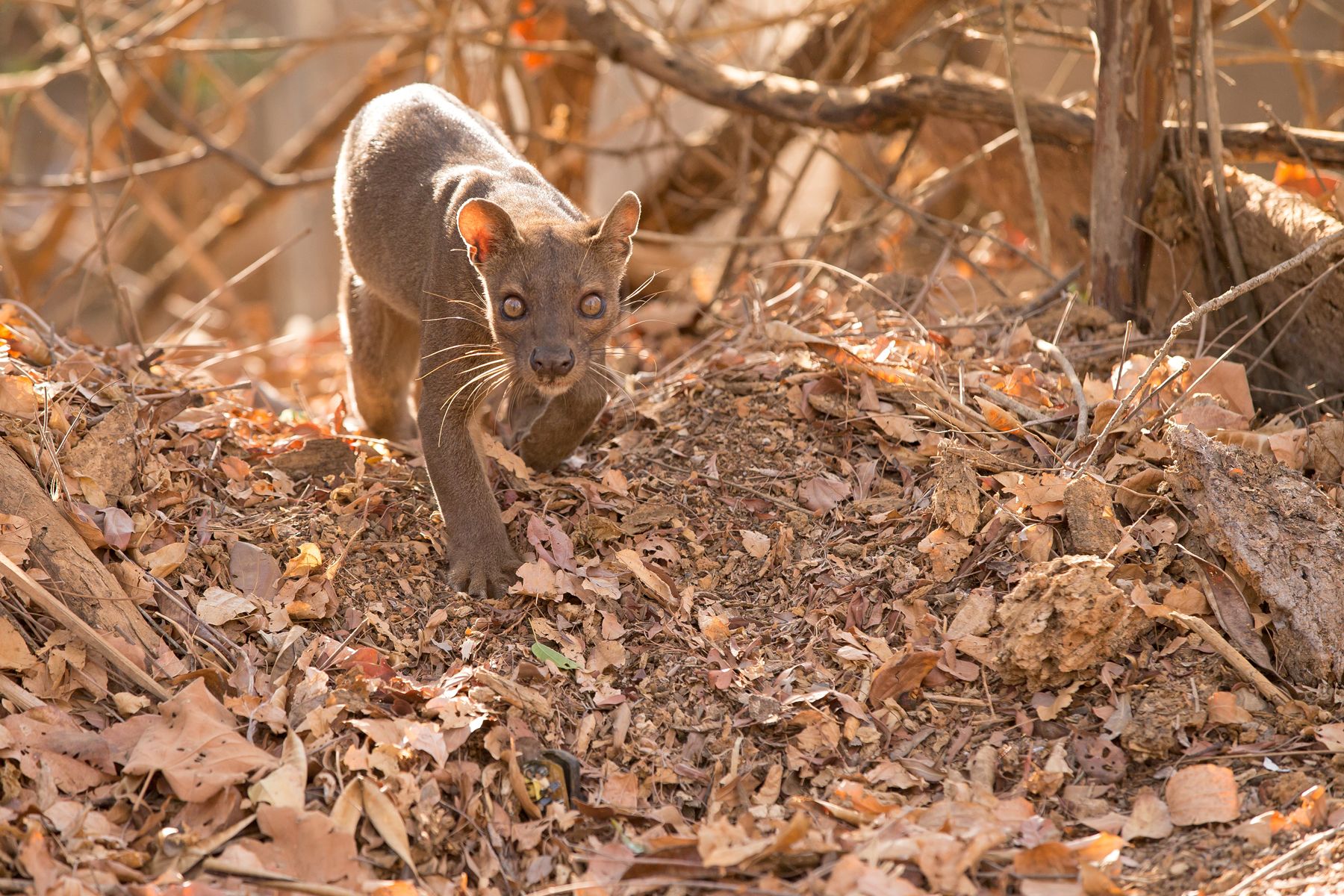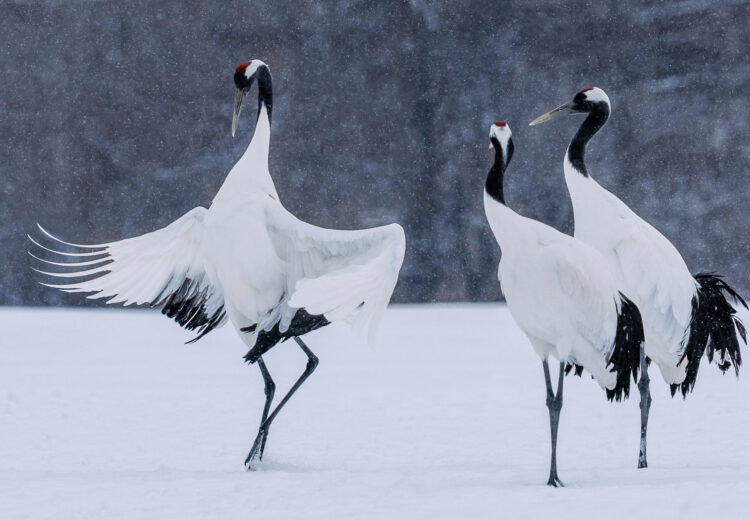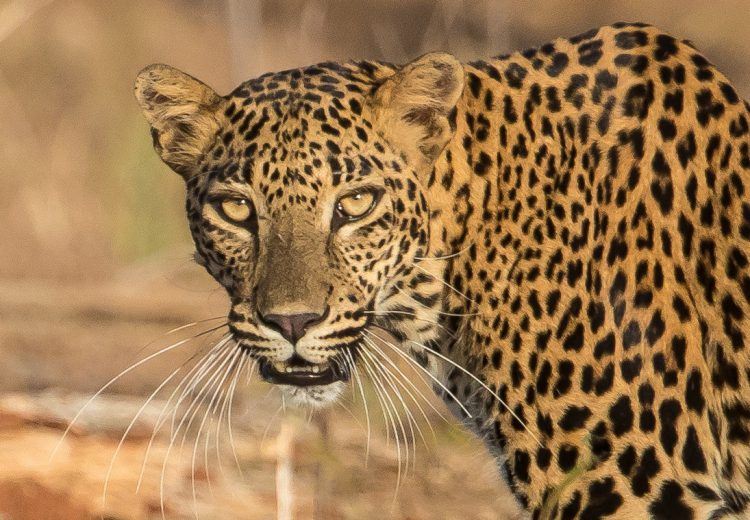Madagascar
MADAGASCAR: A WORLD APART – The Natural Curiosities of the ‘Eighth Continent’





















































The glorious yellow flowers of Pachypodium rosulatum or Elephant's Foot Plant light up the landscape at Isalo (Image by Mike Watson)

Red-fronted brown Lemur portrait at Kirindy Forest (Image by Mike Watson)

Lemurs often have staring eyes and this Verreaux's Sifaka is no exception (Image by Pete Morris)

The amazing convergent evolved hedgehog lookalike, Lowland Streaked Tenrec at Andasibe-Mantadia National Park (Image by Mike Watson)

They will be difficult to photograph they said. This Long-tailed Ground Roller at Ifaty didn't pose a problem (Image by Mike Watson)

The bizarre Giraffe-necked Weevil is a much photographed oddity of Madagascar's eastern rainforest (Image by Mike Watson)

Portrait of a Panther Chameleon in Madagascar (Image by Dani Velasco)

A climbing Ring-tailed Lemur (Image by Dani Velasco)

Olive Bee-eaters are a regular feature of the Madagascar countryside but they do not all pose like this one did (Image by Mike Watson)

The Indri or Babakoto is one of the largest lemurs and much the most vociferous (Image by Pete Morris)

Around 20 minutes after sunset, when the crowds have hurried back to the hotels, a red orange glow appears (image by Mike Watson)

Red-tailed Sportive Lemur at its day roost in Kirindy Forest. Another jack-in-the-box lemur! (Image by Mike Watson)

An audience with the critically endangered Indri at Andasibe-Mantadia National Park is an unforgettable experience (Image by Mike Watson)

Red-fronted Brown Lemur is one of the common lemurs of the dry forests of Madagascar's west (Image by Wild Images guest Paul Harknett)

Verreaux's Sifaka at Kirindy Forest. A delightful ground level encounter (Image by Mike Watson)

Ring-tailed Lemur is known as ‘Maki’ in Madagascar (image by Mike Watson)

An old alpha male Fosa at Kirindy Forest clings on to his fading powers (Image by Mike Watson)

Three-eyed Lizard is a common sight in the southwest of the country (Image by Mike Watson)

Ring-tailed Lemurs are one of Madagascar's most charismatic lemurs (Image by Pete Morris)

Another Panther Chameleon, this time exhibiting a very different colour (Image by Pete Morris)

Mangrove sunset at Ifaty (Image by Mike Watson)

Short-horned Chameleon, Andasibe-Mantadia National Park (Image by Mike Watson)

A dreamy gaze from a Verreaux’s Sifaka at Kirindy (image by Mike Watson)

Verreaux's Sifaka at Kirindy was something very special (Image by Mike Watson)


A tiny Grey Mouse Lemur peers from its daytime roosting hole at Kirindy (image by Mike Watson)

Touching distance views of Aye-aye was a tour highlight for most (image by Mike Watson)

Lesser Hedgehog Tenrec in Ifaty's Spiny Forest. Can you believe it is not even a member of the same order let alone family as hedgehogs and is instead a product of convergent evolution? (Image by Mike Watson)

A prowling young Fosa at Kirindy Forest. It will not be long before this strong youngster ousts the old stager (Image by Mike Watson)

Portrait of a Red-fronted Brown Lemur (Image by Pete Morris)

Ring-tailed Lemur motion blur at Isalo National Park (Image by Mike Watson)

You can often get really close to Ring-tailed Lemurs (Image by Pete Morris)

Sunset over the Allée des Baobabs, Morondava (Image by Mike Watson)

This gnarled old Fosa appeared to be the alpha male at Kirindy (Image by Mike Watson)

Fosa. This was a yawn rather than an aggressive gesture, thankfully (Image by Mike Watson)

A toothless yawn by the old male Fosa shows why he has resorted to scavenging around the research station at Kirindy Forest (Image by Mike Watson)

Portrait of a Verreaux's Sifaka (Image by Dani Velasco)

Verreaux’s Sifaka family at Kirindy Forest (image by Mike Watson)

Sunset silhouette of one of Madagascar's magnificent baobab trees (Image by Wild Images guest Paul Harknett)

They said this one would be hard to photograph too! Sub-desert Mesite at Ifaty (Image by Mike Watson)

Fosa at Kirindy Forest. Is it a dog, hyena, cat or a civet? Actually it's a member of Madagascar's endemic mammal family of carnivores, the Eupleridae, which are thought to have descended from a single pregnant female ancestor carried to the island from Africa on floating vegetation! (Image by Mike Watson)

A tree-climbing Fosa shows its amazing flexible ankles, which allow it to descend trees head first, a big advantage when chasing lemurs! (Image by Mike Watson)

A stunningly beautiful female Fosa at Kirindy Forest (Image by Mike Watson)

Mossy Leaf-tailed Gecko is another of Madagascar's fantastical night creatures, when they do not need to rely of their cryptic camouflage and are therefore much easier to find (Image by Mike Watson)

Verreaux's Sifaka. Lemurs are the most charismatic creatures among Madagascar's diverse wildlife (Image by Dani Velasco)

Ring-tailed Lemur at Isalo, known locally as 'Maki' is probably Madagascar's best known lemur (Image by Mike Watson)

Red-tailed Sportive Lemur does its best 'Jack-in-the-box' impression in Kirindy Forest (Image by Wild Images guest Paul Harknett)

This male Oustalet's Chameleon at Zombitse National Park is the big daddy of all the chameleons! (Image by Mike Watson)

The Giraffe Weevil is one of the island's weirdest wildlife inhabitants (Image by Dani Velasco)

The enigmatic Fosa, is it a cat, dog, hyena or a mongoose? None of the above. It is a member of Madagascar's endemic family of carnivores (Image by Wild Images guest Paul Harknett)

Madagascar is truly a wildlife wonderland for geckos and chameleons. This is a Spear-point Leaf-tail Gecko (Image by Pete Morris)
|
Saturday 4th October –
Sunday 19th October 2025 Leaders: Virginia Wilde, Wild Images leader to be announced and local naturalist guides |
16 Days | Group Size Limit 7 (2 spaces) |
|
Sunday 4th October –
Monday 19th October 2026 Leaders: Wild Images leader to be announced and local naturalist guides |
16 Days | Group Size Limit 7 |
MADAGASCAR WILDLIFE PHOTOGRAPHY TOURS WITH WILD IMAGES
Madagascar richly deserves its reputation as one of the world’s top venues for wildlife photography tours and in recent times has become a veritable Mecca for wildlife photographers. The degree of endemism (unique species) in this one island is simply staggering. Madagascar is home to almost 160 endemic mammals, including no fewer than 99 lemurs! It also has some 110 endemic bird species, 260 endemic reptiles, 60 endemic snakes (thankfully none of which are venomous) and 290 endemic amphibians, not to mention countless endemic insects and plants, and more chameleons than anywhere else on earth! Madagascar photography tours are not only truly unique but an enjoyable wildlife adventure.
Many of these wonderful creatures are also very photogenic and approachable, making Madagascar an obvious choice for wildlife photography. Separated from the African continent for 160 million years and then India for around 65 million years, Madagascar is a fascinating laboratory of evolution and has featured in many TV documentaries, including David Attenborough’s ‘Natural Curiosities’.
You could buy a small house for the cost of photographing all of Madagascar’s unique wildlife so, on this special ‘best of’ Madagascar wildlife photography tours itinerary, we aim to cover a wide variety of fauna, as well as ‘cherry-picking’ some of its most spectacular endemic creatures, large and small.
Amongst naturalists, the island is best known for its fabulous lemurs, man’s most distant cousins, ranging in size from tiny mouse-lemurs to the great Indri, and one of our main aims is to spend time photographing some of the most spectacular members of this family. We will also target photography opportunities with some of Madagascar’s other special mammals and birds, as well as chameleons and other herptiles.
Madagascar’s landscapes are just as varied and impressive as are its weird and wonderful wildlife, from the peculiar spiny forests of the west coast to the rugged sandstone canyons of the interior and the moist tropical rainforests of the eastern mountains. All of these make interesting subjects for photography during this exciting photographic journey through the island
Humans reached Madagascar around 2000 years ago, first from Southeast Asia in their primitive outrigger canoes and then, around 1000 year later, from Africa as well. Sadly their catastrophic impact on Madagascar’s fauna and flora continues apace. The Madagascar megafauna, which included 15 giant lemurs, elephant birds, giant tortoises and hippopotamuses, died out soon after the arrival of man and the remaining lemurs are now restricted to less than 10% of the island owing to ongoing ‘slash and burn’ agricultural activities. Fortunately much of Madagascar’s incredibly diverse wildlife can still be found in protected areas that have been spared the axe. As in so many parts of the developing world, a visit to Madagascar sooner rather than later is a good idea.
Accommodation & Road Transport
The hotels/lodges used during our Madagascar wildlife photography tour are almost all of good standard. The lodge at Kirindy is fairly simple but clean and comfortable. Road transport is by small coach or minibus and roads are variable in quality (although mostly much improved on the past). There are some fairly long drives.
Walking
The walking effort during our Madagascar photography tour is mostly easy, but there are some moderate hikes.
Climate
At lower altitudes in Madagascar it will be hot, dry and sunny. At higher altitudes the weather is similar but temperatures are cool to warm. It will be rather humid, especially in the east.
Photographic Equipment
For wildlife photography of birds and some tree-dwelling lemurs we recommend a telephoto (with or without converter) with a focal length of 400–600mm on a full-frame DSLR . There will also be some very approachable wildlife in the range of 100-200mm upwards and so a 100-400mm zoom is ideal for many subjects.
Opportunities for macro photography of herptiles for instance are particularly good, but with limited light in the forests, fill-in flash may be desirable.
As well as having some very approachable wildlife suitable for wide-angle photography, Madagascar is also full of panoramic views and a lens in the 16-35mm range is ideal for landscape photography.
You can also get great results with many subjects with a high quality digital bridge camera with an optical zoom of 18-20x or more and a wide-angle equivalent to around 24mm.
Be sure to bring plenty of spare battery power. Electricity supplies in Madagascar are not always completely reliable.
If you have questions about what equipment you ought to bring, please contact us.
Photographic Highlights
- Ring-tailed Lemurs all around us in a shaded ravine in the lovely Isalo National Park
- Very close encounters with the fearsome Fosa, Madagascar’s largest predator at Kirindy, the only place in the world it can be seen on a regular basis
- Walking among the famous ‘Avenue of the Baobabs’ near Morondava at sunset
- Long-tailed Ground Rollers and the weird Subdesert Mesite in the other-worldly spiny forest at Ifaty
- Looking up at a group of majestic Indris, the largest of the extant lemurs, as they sing their extraordinary morning chorus to a neighbouring clan
- The extraordinary, endangered, nocturnal Aye-aye, the most famous and most bizarre lemur of them all
- Endemic birds as fancy as their French names such as Verreaux’s Coua and Lafresnaye’s Vanga in the thorny bushlands of the southwest
- The world’s most spectacular and largest chameleons Oustalet’s walks along a branch next to us in slow motion, changing colour as it enters the shader
- A wide variety of other photogenic wildlife including endemic frogs, leaf-tailed geckos, snakes and other herptiles
- Travelling through a strange landscape where 90% of all flora and fauna is endemic, so almost everything is different-looking!
- Photographing the fascinating sandstone rocky landscapes of Isalo National Park
- A delightful White-browed Owl peers down at us from its daytime roosting tree at Zombitse Forest
- The world’s most spectacular and largest chameleons Oustalet’s walks along a branch next to us in slow motion, changing colour as it enters the shade
- Sitting next to gorgeous Verreaux’s Sifakas Red-fronted Brown Lemurs as they tuck in to Ju Ju berries at a feeding station at Kirindy
- A huge Hog-nosed Snake searches for prey in the leaf litter of Kirindy Forest but we need not worry, there are no venomous snakes in Madagascar
- Meeting other spectacular rainforest lemurs including the critically endangered Black-and-white Ruffed Lemur and Diademed Sifaka in the Andasibe area
- Photograph a wide variety of other nocturnal critters on night walks, which could be yet another chameleon, a Leaf-tailed Gecko or a tiny leaf frog
- Gaze in amazement at the camouflage of a Collared Nightjar and then realise it is actually two birds, not just one, roosting side by side on the forest floor
- Figuring out the best macro angle to shoot the bizarre Giraffe-necked Weevil, another of Madagascar’s natural curiosities
- Al fresco dining on the west coast in the warm evening air listening to the calls of Madagascar Nightjars
OUTLINE ITINERARY
- Day 1: Arrive in Antananarivo
- Day 2: Fly to Tulear (Tollara) and drive to Ifaty
- Day 3: Full day of photography in the Spiny Forest of Ifaty
- Day 4: Final morning of photography at Ifaty. Drive to Isalo
- Day 5: Full day of photography in Isalo
- Day 6: Drive back to Tulear stopping at Zombitse Vohibasa National Park en-route. Fly to Antananarivo
- Day 7: Fly from Antananarivo to Morondava. Drive to Kirindy
- Days 8-9: Full days of photography at Kirindy
- Day 10: Drive to Morondava and visit Avenue of Baobabs until sunset
- Day 11: Sunrise at Avenue of Baobabs. Fly to Antananarivo. Drive to Andasibe.
- Days 12-13: Full days of photography at Analamazoatra Special Reserve
- Day 14: Final morning photography at Andasibe. Drive to Lac Ampitabe and take a boat to La Palmarium
- Day 15: Full day of photography at La Palmarium
- Day 16: Final morning of photography at La Palmarium before driving back to Antananarivo where our tour will end in the evening
To see a larger map, click on the square-like ‘enlarge’ icon in the upper right of the map box.
To see (or hide) the ‘map legend’, click on the icon with an arrow in the upper left of the map box.
To change to a satellite view, which is great for seeing the physical terrain (and for seeing really fine details by repetitive use of the + button), click on the square ‘map view’ icon in the lower left corner of the ‘map legend’.
PRICE INFORMATION
Wild Images Inclusions: Our tour prices include surface transportation, accommodations, meals and entrance fees.
Our tour prices also include these flights: Antananarivo-Tulear (Toliara)-Antananarivo and Antananarivo-Morondava-Antananarivo.
Our tour prices also include all tips for local guides, drivers and accommodation/restaurant staff. We also include payments for local people who are willing to be photographed.
Deposit: 20% of the total tour price. Our office will let you know what deposit amount is due, in order to confirm your booking, following receipt of your online booking form.
TO BOOK THIS TOUR: Click here (you will need the tour dates)
2025: confirmed price £6340, $8290, €7620, AUD12510. Antananarivo/Antananarivo.
2026: provisional price £6490, $8490, €7810, AUD12810. Antananarivo/Antananarivo.
Single Supplement: 2025: £560, $740, €680, AUD1110.
Single Supplement: 2026: £570, $750, €690, AUD1130.
There may not be enough rooms for all those wanting single occupancy at Kirindy as accommodation is limited there. There is no supplement for singles at Kirindy, if available at the time.
If you are travelling alone, the single supplement will not apply if you are willing to share a room and there is a room-mate of the same sex available.
This tour is priced in US Dollars. Amounts shown in other currencies are indicative.
Air Travel To & From The Tour: Our in-house IATA ticket agency will be pleased to arrange your air travel on request, or you may arrange this yourself if you prefer.
MADAGASCAR WILDLIFE PHOTOGRAPHY TOUR: DETAILED ITINERARY
Day 1: Our Madagascar wildlife photography tour begins this evening in Antananarivo, the capital city of Madagascar, where we will spend the night. Often referred to simply as ‘Tana’, Antananarivo is a strange mixture of traditional Malagasy, French Colonial and modern architecture. Traditional Malagasy architecture has many Asian roots and the buildings look much closer to those one would see in parts of Nepal than anything found on the African mainland, reflecting the Asiatic origins of most of the Malagasy themselves.
Day 2: From Antananarivo, situated on the high interior plateau of Madagascar, we travel first to the southwest coast of the island, taking a flight to Tulear (or Toliara), from where we continue by road to nearby Ifaty for a two nights stay. This afternoon we will begin our exploration of the Ifaty area.
Day 3: In the strange and very photogenic ‘spiny forest’ of Southwest Madagascar, we can expect to encounter an array of endemic Madagascan wildlife.
We should enjoy close encounters with both the strange Subdesert Mesite and the even-stranger-looking Long-tailed Ground Roller, two of Madagascar’s most sought-after bird photography subjects. Other great birds include Running Coua, Madagascar Nightjar, Sickle-billed and Lafresnaye’s Vangas and with luck the rare Banded Kestrel.
Mammals found here will include our first lemurs, and we will be hoping for photographic encounters with Grey Mouse-Lemur, Grey-brown Mouse-Lemur and White-footed Sportive Lemur. Lesser Hedgehog Tenrec can also be found around Ifaty. Tenrecs are a hedgehog-like, African and Madagascan mammal family, sometimes known as Otter-Shrews, which have diversified like crazy in Madagascar. They are peculiar amongst placental mammals in possessing a single rear opening like a cloaca, more commonly found in birds and reptiles. Other inhabitants of the spiny forest include the reintroduced Ring-tailed Lemur.
Walking along the sandy trails through the spiny forest is a fantastic experience. Tall, many-branched Didierea trees with a potent armour of spines give the impression of being witches’ broomsticks planted in the ground. Set amongst the many different kinds of Didierea trees are strange euphorbias and many squat, bloated Fony Baobabs. The feel of this bizarre forest, especially as dusk approaches, is of something dreamed up by Tolkien.
Day 4: After a final wildlife and forest landscape photography session at Ifaty, we will drive northeastwards to Isalo National Park in Madagascar’s Ihorombe region for a two nights stay.
Day 5: We will spend the day exploring just a small part of the 815 square kilometres (about 315 square miles) that comprises Isalo National Park. Amongst its starkly impressive eroded sandstone ‘ruiniforms’, the main wildlife photography attraction is its Ring-tailed Lemurs. In leafy canyons we can expect to encounter some of these iconic primates, first made famous by the BBC’s TV programme ‘Animal Magic’ featuring Johnny Morris and ‘Dotty’ a Ring-tailed Lemur at Bristol Zoo. Once hunted in this area, these beautiful creatures have only become habituated and easy to see and photograph relatively recently. They also ought to be in better condition than the ringtails at the more-visited Berenty reserve in Southeast Madagascar, which eat the leaves of Leucaena leucocephala, an introduced tree containing toxic mimosine that has been linked to hair loss or ‘bald lemur syndrome’, first noticed there in the 1990s.
Red-fronted Brown Lemurs and gorgeous Verreaux’s Sifakas can also be found here. The latter, which is surely another of Madagascar’s most iconic wildlife photography subjects, is well known for its ‘dancing’ bipedal means of crossing the ground between one tree to another.
The quiet trails and canyons of Isalo are also home to other wonderful critters including several fantastic chameleons such as Oustalet’s (or Malagasy Giant) Chameleon, Warty (or Spiny/Crocodile) Chameleon and Bright-green Jeweled Chameleon. Madagascar is the world’s capital of chameleons, with over half of all the species found on earth, including both the largest and the smallest! In addition, the peculiar xerophytic Elephant’s Foot trees ought to be in flower now, adding splashes of yellow to the Isalo landscape of sharp-edged, almost karst-like, sandstone ridges. The outrageous and endangered Rainbow Burrowing Frog also occurs here, although this ‘explosive breeder’ will probably be dormant during the time of our visit (which is in the long dry season).
Day 6: Today we will retrace our steps to Tulear, from where we will take a flight to Antananarivo for an overnight stay.
We will stop en route to Tulear at Zombitse-Vohibasia National Park. This relatively small wildlife sanctuary protects a relict of a once much more extensive forest that is still home to the extremely localized Appert’s Greenbul. This dull-looking bird is hardly a star creature for wildlife photography, but much more interesting subjects in this dry deciduous forest include Coquerel’s and Giant Couas, White-browed Hawk-Owl, Madagascan Hoopoe and Rufous Vanga (which has a repertoire of strange vocalizations). The forest is also a great place to see and photograph the bizarre Cuckoo Roller.
Zombitse also holds several species of lemurs. We may have another encounter here with Verreaux’s Sifaka and we may even find the endangered Hubbard’s Sportive Lemur at its daytime roost. Zombitsy is also a good place to see the beautiful Standing’s Day Gecko, which is endemic to southwest Madagascar, and en route to Tulear we may encounter Madagascar Sandgrouse.
Day 7: We will take a flight today from Antananarivo to Morondava, the capital of Madagascar’s Menabe region on its west coast. From Morondava we will drive to Kirindy Forest Reserve, around 40km (25 miles) away and our base for the next three nights. We should arrive in time for some initial exploration.
Days 8-9: Kirindy is a 100 square kilometres (39 square miles) private wildlife reserve which was originally an experiment in sustainable timber harvesting. Although the reserve holds many of the special lowland forest creatures of western Madagascar, it is particularly well known as the best place in the country to see the usually shy and retiring Fosa (or Fossa, which is pronounced ‘foo-sa’), Madagascar’s largest carnivore. The Fosa resembles a small Puma and was once even thought to be a member of the cat family, but is now known to be more closely related to the mongoose family. Its classification has been debated over the years as it also shares some traits with cats, civets, and even hyaenas!
The other main carnivore here is the Northern Bokiboky (or Narrow-striped Mongoose). Kirindy is also the only place one can find the nocturnal and endangered Giant Jumping (or Malagasy Giant) Rat, a large rodent with a severely restricted range of only about 20 square kilometres! Like its rodent cousin in Africa, the Spring Hare, it can hop, but it can also run on all fours.
Lemurs are well represented at Kirindy and diurnal species include both Verreaux’s Sifaka and Red-fronted Brown Lemur which are habituated here. In addition, there is a host of nocturnal lemurs, including Madame Berthe’s Mouse-Lemur (the world’s smallest primate), Grey Mouse-Lemur, Red-tailed Sportive Lemur, Pale Fork-marked Lemur, Coquerel’s Giant Dwarf Lemur and Fat-tailed Dwarf Lemur. With persistence, we will see and photograph a number of these strange critters of the Madagascan night.
Several tenrecs can also be found here, including Common, Greater Hedgehog, Lesser Hedgehog and Large-eared Tenrecs.
Reptiles are also abundant and include Henkel’s Leaf-tailed Gecko, Big-headed Gecko, Giant Hog-nosed Snake, Spear-nosed Snake and Kapidolo (or Flat-backed Spider Tortoise), although we will need luck to see any of them during our visit. The eggs of the threatened Labord’s Chameleon will also be on view here at the time of our visit, but the young and adults live only for four or five months in total between November and March, the shortest lifespan of any vertebrate!
Photogenic birds at Kirindy include White-breasted Mesite, Crested and sometimes Coquerel’s Couas, Sickle-billed, White-headed, Rufous, Blue and Chabert’s Vangas, Cuckoo Roller, Madagascar Harrier-Hawk and Lesser and Greater Vasa Parrots.
All in all the potential for wildlife photography at Kirindy is awesome, so our three days visit is barely going to seem long enough!
Day 10: After spending much of the day at Kirindy, we will drive back to Morondava for an overnight stay. We will visit the famous ‘Avenue of Baobabs’ this evening, arriving before sunset. Madagascar’s first National Monument, the baobabs are relics of an ancient forest, which was cleared by man, leaving only these 30m-tall (100ft-tall) isolated forest giants. Around 25 endemic Grandidier’s Baobabs (Adansonia grandidieri) line a 250m stretch of road and have become one of the most iconic scenes of rural Madagascar. Some 7 kilometres (43 miles) further to the northwest are the famous ‘Baobabs Amoureux’ – two Western Baobabs twisted together and said to signify the impossible love between two villagers already assigned to other partners. The baobabs make for some interesting wide-angle photography, especially in the soft light of dusk and dawn.
Day 11: We will return to the Avenue of Baobabs early this morning, providing flight schedules permit. Afterwards, we will take a flight back to Antananarivo and then drive east to Andasibe, our base for the next three nights.
Days 12-13: The Analamazaotra Special Reserve at Andasibe (formerly Perinet) protects some of the faunistically richest east coast rainforest in Madagascar. Nearby, the more recently created Mantadia National Park extends over a much larger area and is largely primary rainforest. We will spend our time in the Andasibe area exploring the rainforest in these two very fine wildlife reserves.
The main photography focus in this incredibly rich forest will be the spectacular black-and-white Indri, the largest of the extant lemurs. (Madagascar’s now extinct megafauna included Archaeoindris, a giant lemur the size of an adult male gorilla!). The Indri’s eerie, wailing call echoing through the forest at dawn is almost as impressive as the lemur itself. Some Indris in this area have become accustomed to visits by eco-tourists, including wildlife photographers, and we should enjoy some great photography opportunities with them.
The wonderful Indri is not, however, the only spectacular lemur that can be found in these forests. We will also be looking for the equally striking Black-and-white Ruffed Lemur and the stunningly beautiful Diademed Sifaka, surely a candidate for ‘Madagascar’s best-looking lemur’.
A host of smaller and mostly nocturnal lemurs in this area includes Goodman’s Mouse-Lemur and and Hairy-eared Dwarf Lemur.
With such mammalian diversity occurring in these forests, it is no surprise that there is also a spectacular array of forest birds here and we will spend some time searching for, and trying to photograph, the beautiful but secretive Pitta-like, Rufous-headed, Scaly and Short-legged Ground Rollers, the impressive Madagascar Owl and the attractive Collared Nightjar, although most of these are difficult to find.
The big chameleon of the eastern forests, Parson’s Chameleon, occurs here and we will hope for a close, slow-motion photography encounter with one of these fabulous creatures, which are also amongst the worst vertebrate parents going and take no care of their young whatsoever once their eggs are laid! At around half a metre (19 inches) long when fully grown, Parson’s vies with Oustalet’s Chameleon for the title of ‘the world’s largest chameleon’.
The forests of the Andasibe region are also rich in invertebrates and a particular attraction is the bizarre Giraffe-necked Weevil, the male of which is very popular with wildlife photographers and happily fairly easy to find.
Day 14: After a final photography session in the Andasibe region, we will head eastwards to Lac Ampitabe in the coastal lowlands. The final part of the journey to Le Palmarium, where we will stay for two nights, is by boat.
Day 15: Le Palmarium protects one of the few remaining fragments of east coast littoral rainforest remaining in this region of Madagascar, just 50 hectares (about 124 acres) in total!
There are a mixture of lemur species here, some indigenous to the area like Black-and-white Ruffed Lemur and the huge Indri, while (rather unfortunately, but providing some wonderful additional photographic opportunities) there are introduced Red Ruffed Lemurs (from Northeast Madagascar), Crowned Lemurs (from North Madagascar) and Black Lemurs (from Northwest Madagascar), plus some hybrids!
By far the most exciting and important wildlife photography feature of Le Palmarium is the population of wild Aye-ayes that survives on an island in the lake, safe from local people for whom the Aye-aye is, tragically, ‘fady’ or taboo, so universally feared, hated and persecuted. We will go there both evenings to watch and photograph the Aye-ayes as they emerge from their nests. This is surely the best and ‘easiest’ place to photograph this charismatic and rather sinister-looking nocturnal species in the wild, as the animals here are less wary of humans than in most other localities. Even so, patience, persistence and care are needed.
Day 16: After a final session at Le Palmarium, we will make our way back to Antananarivo, where our Madagascar wildlife photography tour comes to a close this evening.
Note: If you find you have time on your hands at Antananarivo, either before or after the tour, because of the infrequent international flight schedules, we can arrange for a sightseeing exploration of the city for you on request.
Madagascar: A World Apart Photography Tour Report 2023
For more than a few moments – during our morning tour walk in a tangle of primary rainforest in eastern Madagascar – I wondered if we had stumbled into a primaeval world. Amid the dense vegetation: singing Indri, vivid chameleons, and enigmatic birds – some of the weirdest and rarest wildlife on Earth. At its […]
View Report
Madagascar: A World Apart Photography Tour Report 2022
by Mike Watson
Many of us had been waiting a long time to make the journey to the ‘Eighth Continent’, so it was a great relief to finally set foot in Antananarivo’s shiny new international airport terminal and embark on another odyssey of Malagasy wildlife. We revisited favourite destinations: Kirindy Forest in the west; the Spiny Forest of […]
View Report
Madagascar: A World Apart Photography Tour Report 2018
by Mike Watson
The second Wild Images photo tour of Madagascar was another great success, resulting in some even better photographic encounters with some of the ‘Eighth Continent’s’ most enigmatic wildlife than last time. From the outrageously confiding Long-tailed Ground Roller of the Spiny Forest of southwest Madagascar, found nowhere else in the world, to the equally tame […]
View Report
Madagascar: A World Apart Photography Tour Report 2017
by Mike Watson
The inaugural Wild Images photo tour of Madagascar was a great success, resulting in some memorable photographic encounters with some of the ‘Eighth Continent’s’ most enigmatic wildlife. From the outrageously confiding Long-tailed Ground Roller and Subdesert Mesite of the Spiny Forest of southwest Madagascar, both found nowhere else in the world, to the equally tame […]
View Report
Other Wild Images Tours featuring islands
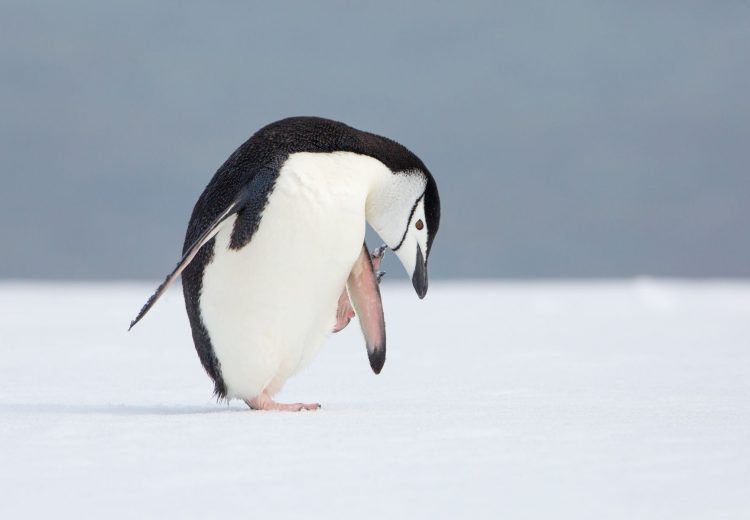
Falkland Islands & South Georgia
November-December 2024
ANTARCTICA, FALKLAND ISLANDS & SOUTH GEORGIA: Photography on a different planet
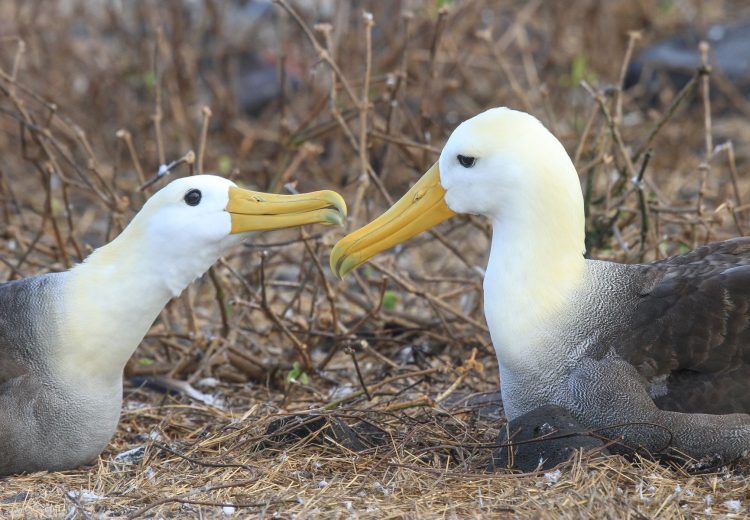
South America (including Galapagos)
May 2025


